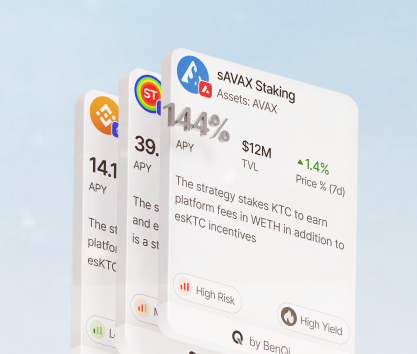Tokens pegged by fiat currencies and other crypto assets can be extremely useful for interconnected decentralized ecosystems that rely on them for stability and transparency in their operations. One of the first efficient projects in this category was MakerDAO which is still one of the most prominent platforms for lending and borrowing $DAI softly pegged to the US dollar.
As of the time of writing, MakerDAO had over $7.06 billion in total value locked (TVL) and a significant surplus of DAI. 5.2 billion tokens backed by cryptocurrencies by at least 46% are circulating in the market making it essential for many DeFi protocols.
This particular platform is only one example of successful stablecoins in DeFi. These are incredibly valuable digital assets issued by decentralized finance apps to facilitate faster trading and easier adoption for newcomers or people who find themselves on the border between crypto and fiat. Understanding how to use them to maximize the efficiency of a portfolio is an extremely important skill for any investor.
How to achieve high DeFi stablecoin yield
Before we jump straight into the topic and discuss potential ways to improve your market positions, it is imperative to understand the concept of these digital assets and their most prominent use cases. Many advantages of these coins pegged to various valuables make them incredibly lucrative for all kinds of investors regardless of their risk tolerance and management styles.
We will briefly cover several topics including definitions, principles of operation, and current market trends. These are crucial bits of information that you need to understand some of the strategies that we will discuss later in this article.
What is a stablecoin in decentralized finance (DeFi)?
This type of digital asset is designed to remain as close to the price of a reference as possible. For example, USDT (Tether) is pegged to the US dollar. While some fluctuations within 1 — 2 cents are acceptable, the difference must remain indistinguishable. The importance of this parity is hard to overestimate as retail investors should have a good idea of the value of their holdings at any moment by comparing them to the reference.
There are several methods of providing price stability. While some algorithmic types of stable digital assets have been experimented with, most of them do not survive in the long term and fail to deliver on their promises. The infamous case of Terra Luna resulted in a massive $45 billion loss of value in just a week in 2022. We won’t cover them as much since they represent a relatively tiny portion of the overall crypto ecosystem.
Backing a token using reserves in all sorts of valuables is a much better and more reliable way of securing the price and making it as close to the reference as possible. If users know that they can easily exchange their digital assets for things that have value for them and the economy, prices are more likely to remain stable and investors won’t be encouraged to take out their funds.
It is possible to use various reserves to back stablecoins in DeFi:
- Fiat currencies. The most obvious and hugely popular reference and backing asset is a good old US dollar or euro. Treasuries of DeFi protocols are filled with holdings that represent the value of issued tokens. Fluctuations and price discrepancies happen due to the extraction of funds necessary for maintaining operations. Paying for custody, licensing, regulatory compliance, and audits can be quite expensive. The biggest example of this particular approach is Tether backed by USD holdings (close to 28%). Despite the discrepancy between circulation and reserves, it is still one of the most widely used tokens out there.
- Commodities. Precious metals and even futures on oil can be used as valuable holdings in reserves allowing users to simply exchange their tokens for he portion of commodities if they choose to do so. As a result, redeemed tokens are either reissued or removed from circulation altogether. Prominent examples are PAX Gold and Silver Token pegged to the price of underlying commodities. The design of such protocols often requires even more funding for reserve servicing.
- Cryptocurrencies. Yes, digital assets can also be used to back a stablecoin. Using collateral is a great concept in theory but has failed several times in practice. The implementation of this method requires complex technological frameworks and sophistication in the designs of smart contracts allowing users to take out loans using crypto as collateral. The most famous project is MakerDAO, other notable examples are Havven and Wrapped Bitcoin.
DeFi protocols need additional funding and capital retention. They often provide incentives to investors willing to provide their holdings. Yields are comparatively lower compared to what you can expect from projects without the necessity to keep issued digital assets pegged to a specific reference. This setup can be dangerous as shown by USDD, LUNA, and DEI. These projects promised to pay exorbitant yields yet failed to keep the value of tokens tied to chosen references in the long run.
On average, an investor should not expect incredibly high returns on their investments in reliable projects that often have APYs close to 2% — 7%. These numbers are still higher than many high-yield bank deposits can give you, but they are quite low compared to what a slight increase in risk can generate. It is hugely important for capital holders to carefully assess investment opportunities befor jumping in head-first.
We have several interesting high-yield platforms for stablecoins.
Aerodrom Finance for high yield stablecoin investments
Launched at the beginning of 2024, this platform is strongly focused on generating liquidity as a next-gen automatic market maker. The technological foundation of the project is designed using the BASE framework. It is a solid choice for people who are interested in supporting sustainable growth in the larger ecosystem while enjoying lucrative APYs. Some pools reward users with up to 1,230% APY in AERO.
Earning these tokens can be a good idea since the price managed to keep its head above the launch price. Market dynamics have been solid. As of the time of writing, the $AERO token had a massive $375 million market cap and good trading volumes (above $10 million daily). As a relatively new project, it does have some technological issues and the interface of the Dapp is still wanting. However, investors looking for profit maximization should look into it.
Pendle — a perfect place for yield farming
Designed as a centralized hub for managing yields, Pendle is a great example of a platform that tries to deliver on its promises by innovating existing products. For example, this protocol offers three distinctly different approaches to yield management:
- Tokenization. Users can wrap their stakes into SY tokens that can be immediately broken down into Principal and Yield tokens which are fully compatible with the automatic market maker.
- Pendle AMM. Tokenized yields can be quickly traded. The best thing is that you don’t have to understand the principles of market-making to start working.
- vePendle is the governance token of the protocol allowing users to actively participate in the development process.
Fixed yields on the platform are very generous. Investors earn up to 11.8% on weETH, 10.66% on sUSDe, and 8.74% on rsETH. Potential gains including rewards reach 94% for pools with over $2 million in TVL. Aggressive investors interested in working with projects promising high returns on Ethereum holdings should consider Pendle as a potential target for capital allocation. The $Pendle token is doing quite well and gained over 180% since launch (even after falling from its ATH by 57%).
Aave is still one of top yield DeFi protocols for stablecoins
If you are looking for a reliable platform that can produce high returns, Aave is a solid choice. However, many users are upset that predicting the exact outcomes of investing is close to impossible. On paper, APYs are quite high, but results often leave a bad taste in the mouths of investors who expected much bigger payouts. Despite some grievances, it is still an excellent protocol to work with if you want to maximize returns on stablecoin holdings.
Some pools have incredibly high APYs reaching over 25% on SUSHI and GHO tokens. Popular stablecoins like USDC and SUSD have lower APYs with 30-day averages barely climbing over 6.7% despite base APYs featuring much higher numbers. Some investors say only good things about Aave, others believe that this particular platform is underdelivering on its promises. Regardless of what you think, the native token is performing well in the market with a solid $1.5 billion market cap and over $180 million in daily trading volume.
Exploring the best yield farming strategies with stablecoins
The community of crypto enthusiasts interested in yield farming has come up with a variety of viable strategies to maximize potential returns by doing the most rational thing for an investor: parking their long-term holdings in a place where they can make money. By the end of 2023, yields surged by at least 10% across the board as DeFi protocols competed against each other for cash inflows. Since then, the hype has slowed down. However, yields remained quite high.
Time-tested protocols beat tradfi deposit by a visible margin with MakerDAO and Ethena reaching 7.03% and 10.26% respectively in 30-day average APYs. These numbers seem impressive and should satisfy the vast majority of conservative investors driven by loss aversion. However, riskier capital holders may try fishing for higher returns by employing different strategies.
HODL — one of the best DeFi income strategies with stablecoins
Some projects offer their users massive payouts just for holding tokens in their wallets. For example, Overnight is a protocol deployed on the BASE blockchain. It pays users up to 8% just for keeping their tokens in the wallet. Extrafi on Optimism offers APYs ranging from 15% to 25% depending on whether you lend stablecoins out.
The main issue with these approaches is the high risk of chains themselves. BASE and Optimism are still struggling to get enough developers on board. These are projects offering technology that can be useful but fails to attract actual users. These are all long-term issues. If you want to get high returns while the iron is hot, checking out these platforms is a good idea.
Liquidity mining with stablecoins
Many investors believe that this particular strategy is the safest and offers solid returns. It is true that some projects can deliver incredible profits. The beauty of the method is in the hands-off style of investing where users just allocate their holdings and forget about them for a while. Some of the highest APYs are offered by Curve.fi and Uniswap with some pools reaching 400% in 30-day mean average APY.
It seems that downsides are non-existent and the hype surrounding DEX liquidity mining is fully justified. The problem is that decentralized exchanges often have to find plenty of workarounds to provide the necessary incentives to users. For example, its highest-paying pool has bridged USDC on Gnosis with wrapped xDAI and Tether on another blockchain altogether. Such yarns of asset connections can be very dangerous and lead to massive impermanent losses and liquidations.
Liquid staking and stacking — reaching for the highest returns in DeFi with stablecoins
Crypto investors are known for their strong desire to see the biggest number. Some of the best places to chase dreams are DeFi protocols allowing for staking on top of liquid staking for outstanding returns on investments. For example, an investor can stake DAI in MakerDAO and receive sDAI representing yield-bearing tokens. The staked token can be used as collateral to borrow USDC on Ajna and restaked on another platform.These approaches expose a portfolio much harder than any other since each layer of stacking adds a new risk to the overall holdings. The practice shows that up to 60% of all Uniswap investors lose money in the long run regardless of which strategy they use. It is hugely important to carefully assess all risks when engaging in strategies like this one.
Top defi yield opportunities with stablecoins in 2024
Investors have many avenues to choose from if they are interested in staking their stablecoins in exchange for big rewards. We strongly believe that each investor should focus on DYOR (doing your own research) and pick protocols that suit their requirements. Among interesting offerings in this sector right now, some stand out in the crowd of stablecoin yield platforms:
- Aerodrom and Beefy offer high APYs on DOLA pairs. This synthetic stablecoin is gaining popularity and acts as a binder in several pools. These protocols offer 24.3% and 24.95% APYs respectively without any base rate.
- Gains Network features two pools for USDC and DAI with $17 million and $19 million TVL respectively. These generate slightly more than 16.3% on average and have base rates of 12.33% and 6.26% respectively.
- KiloEx has a USDT pool with a base APY of 16.15% and a 30-day average of 19.98%. This project has secured over $19 million in TVL and still lacks a native token indicating an opportunity for a future airdrop for depositors.
In conclusion: DeFi yield optimization with stablecoins
Chasing exorbitant APYs is a fun activity that can stimulate adrenaline and dopamine production. However, you should never be in the crypt game if your goal is to get high on naturally produced happiness hormones. Approach the process of portfolio balancing with a clear head and try to build a composition of market positions that produce high returns without exposing you to unnecessary risks. Pick risky investments when you can afford to lose money and stick to safer options when loss aversion becomes a top priority.









